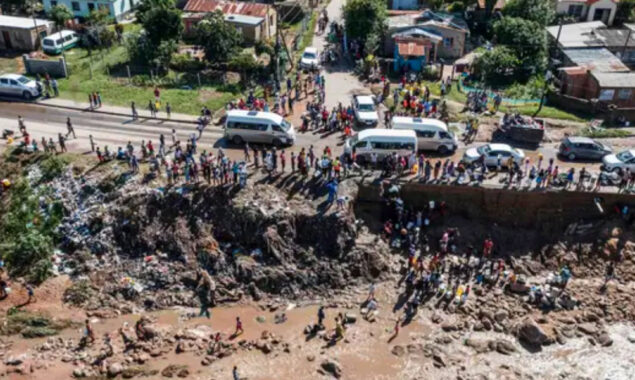Moskva warship sunk as a result of a alleged missile attack
Officially, Russia's Moskva missile cruiser has sunk in the Black Sea in...

When a throng gathered to demand more and better relief for the victims of the deadly floods earlier this week, South African police deployed stun grenades to disperse them.
On Thursday, demonstrators in the eastern city of Durban, where more than 300 people have perished as a result of recent floods, momentarily shut down a key roadway.
It was termed by President Cyril Ramaphosa as “an huge calamity,” and he blamed the climate crisis for it.
Several regions of South Africa are preparing for additional torrential downpours after earlier this week’s record-breaking downpour.
While touring the flooded eThekwini metropolitan region, which includes the city of Durban, President Cyril Ramaphosa remarked, “It is warning us that climate change is serious, it is here.” “We can no longer put off the actions we must take to combat climate change.”
Analysts have repeatedly expressed concern that countries that are already unstable or weak will be put under even more stress as a result of climate change, which will exacerbate existing problems and force governments that are already strapped for cash to use scarce resources to provide relief or rebuild after extreme weather.
The South African meteorological office has issued a severe weather warning for the Easter weekend, predicting further flooding in the provinces of KwaZulu-Natal and other provinces.
The floods, according to meteorologists, was a complete surprise to them. KwaZulu-Natal received almost as much rain in 48 hours as it does in a typical year in some places.
Storm warnings were issued on time, but the rainfall looks to have surpassed even forecasts from the southern African meteorological community, according to a weather service statement.
“We can state with confidence that globally” (as a direct result of global warming and associated climate change), all types of severe and extreme weather are becoming more frequent and more extreme than in the recent past, according to the service, although it is impossible to attribute an individual event to climate crisis. To put it another way, “heavy rain events like this one may be predicted to occur in the future and with increasing regularity.”
Officials anticipate the death toll to rise as search-and-rescue activities continue and the full scope of the damage is known.
More than 248 schools have been damaged and thousands of people have been displaced by the floods. A Methodist church was destroyed in one community. In Umhlatuzana, Chatsworth, near Durban, a river breached its banks and caused significant damage to a Hindu temple there. Flooding created massive landslides in other areas. The busiest port in southern Africa, Durban, was also severely damaged.
Residents in Amaoti, a community north of Durban, had to perch dangerously on the brink of a damaged road in order to reach a broken water pipe.
Officials in Durban say it would take at least a week to restore water and electricity services after floods ruined pipelines and wires around the city and the neighbouring eThekwini metropolitan region. A flurry of aid efforts was under way by non-governmental organisations (NGOs) on Thursday.
The mayor of eThekwini, Mxolisi Kaunda, stated on Thursday that the damage to Durban and the surrounding metropolitan region is assessed at 757 million rand (£39 million).
More than 380 million rand worth of damage has been done to more than 120 schools, forcing the closure of all of the province’s educational institutions for the time being. Angie Motshekga, the education minister, has confirmed the deaths of at least 18 children and one teacher as a result of the floods. As if this wasn’t bad enough already, the devastation is unimaginable. Further, the regions that have already been hit are projected to get additional rain. This is very worrisome.
There was a shortage of food, clothing and other needs, according to volunteers who spoke to the media.
Volunteers in Durban’s Glebelands hostel neighbourhood used the lights on their cell phones to register dozens of displaced persons overnight. Mabheki Sokhela, 51, who helped organise temporary shelter in a community centre, said, “We are simply helping the folks because we care.”
Nearly 30 years after taking power in South Africa, the governing African National Congress (ANC) has come under fire for its reaction to natural catastrophes.
The South African National Defence Force’s air wing was disrupted by the floods, but the military has already dispatched people and helicopters to bring in humanitarian aid to the area.
A flood warning was issued for the province of Eastern Cape on Wednesday afternoon as rain continued to fall in Durban.
More than 350 people were murdered in violent riots in Durban in July, the deadliest unrest in South Africa since apartheid ended.
Catch all the International News, Breaking News Event and Latest News Updates on The BOL News
Download The BOL News App to get the Daily News Update & Follow us on Google News.